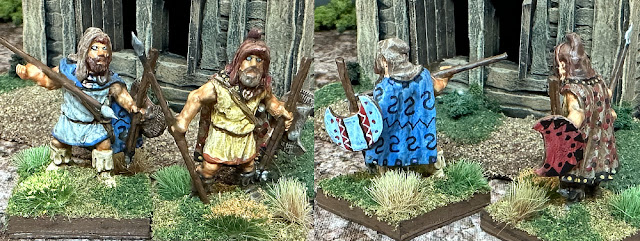 |
My next batch of Thracians -- eight 28mm warriors with javelins from Crusader Miniatures
|
The painting of my next Saga army -- the Ancient Thracians, a Balkan people that raided the Greeks and others in the area -- started up again after Historicon. I am on to the last troop type -- the warriors armed with javelins. This will be the most numerous part of the army, as I plan on fielding three units of nine figures each (in my current warband configuration). This is the first batch of eight.
 |
A look at the freehand patterned cloaks and shield designs that force me to keep my batch size low!
|
Why am I not painting the javelin-armed contingent in three batches of nine? First, I think I may paint up some extra figures in case I want to change the configuration. The biggest reason, though, is that the
Crusader Miniatures (which I purchased from Badger Games) infantry come in packs of eight. Plus, with the decorative cloak patterns, they are a LOT of work. I've found in my years of painting miniatures that if my batch size is too large, I lose motivation and stop painting. By keeping the batch size small, I see progress which inspires me to keep going.
 |
A look at the front and back of two of the figures in this batch of eight Thracian javelinmen
|
One reason I enjoy painting metal miniatures more than using plastic kits -- which seem to be more popular these days -- is the "Assembly" step goes very quickly. All I had to do for these is epoxy on their small crescent shaped shields and the javelin in their throwing hand. I know many (most?) gamers use superglue, but I stick with two-part, 5 minute epoxy. I find it holds best and I rarely have shields or weapons pop off during a game. Typically, I use poster tack to either hold the weapon or miniature in place while the epoxy dries. Sometimes, I will shave off some of the metal to give a flatter surface to join in the shield and forearm, for example.
 |
The detail work on the shields and cloaks is done with a mix of freehand brushwork & micron pens
|
I brush prime my miniatures white, and then do the flesh. I use a craft paint flesh and then do a Terra Cotta colored wash over the flesh to give it a more ruddy look. Next, I do the tunics. I chose mostly pale colors for this batch. Since the cloaks are not decorated other than a contrasting hemline color, I didn't want them to distract from the brighter, fancier cloaks. Ancient sources describe them as patterned in "geometric designs," and looking at examples that survive from Greek vases or frescoes on tombs, you have a lot of leeway in what to paint. I typically sketch out a design with notes designating colors on the cardboard base that I glue my figures to before priming and painting.
 |
I really like how these two cloaks came out, especially the blue one!
|
After the tunics and cloaks, I proceeded to the hooded headdress and the boots. All four clothing pieces receive a highlighting dry brush in a lighter color. Even the leather belts are done in two tones -- a lighter brown base and leather highlight. That's one of the main differences between painting 28mm and 15mm miniatures, I feel. Virtually every bit of detail on the figure gets a base coat and a highlight. It is still not done at that point, though! I go over all my figures with either a brown or black wash. Most figures get both -- the skin, white, yellow, and tan tones on the figure get a brown wash, while the darker colors like reds, greens, blues, and darker browns, get a black wash.
 |
One batch down, and 2-3 more to go on these javelinmen and my Thracian army will be complete!
|
Once the clothing is all done, I do the shields last. For any figure batches which I used a micron pen on, I tend to do a first clear coat BEFORE the wash. I've had the ink run because of my wash otherwise. With a spray of Testors Dullcoate, the ink seems to be pretty dry or sealed in so doesn't run. Last step is the flocking, and another Dullcoate or two, and these guys are ready to hurl their javelins at the enemy on the tabletop!






Great painting Mike.
ReplyDeleteOutstanding work on these.
ReplyDeleteI appreciate it, guys - thanks!
ReplyDeleteGreat painting, love the patterns.
ReplyDelete